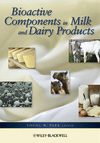Lab Talk: Prebiotics

We all know by now how whey and its many micro-components have evolved into the most profitable constituents of cows milk. Well, watch out whey, cows milk may have a bright and highly lucrative future in the world of prebiotics as a result of findings on human breast milk by researchers at the University of California-Davis.
Researchers have sequenced the genome of a probiotic strain (Bifidobacterium longum subsp. infantis ATCC15697) that lives in the gut of breast-fed infants and uses sugars from human breast milk. The research, published in the Proceedings of the National Academy of Sciences (Nov. 24, 2008), sheds light on why exclusively breast-fed infants normally develop an intestinal microbiota rich in bifidobacteria. These bacteria likely provide significant benefits to the infant by hindering pathogen colonization and priming the gut immune system. But there’s more to the story than just the bifidobacteria.
In their work, the researchers noticed that breast milk contains more than 200 oligosaccharides, which provide no known nutritional purpose to the infant. What they provide is nutrition to the sequenced probiotic strain.
Oligosaccharide prebiotics are any of a group of carbohydrates consisting of a small number (two to 10) of simple sugar molecules. When oligosaccharides are consumed, the undigested portion serves as food for some of the bacteria in the intestine. Oligosaccharides can increase the number of beneficial bacteria in the large intestine while possibly also reducing the population of harmful bacteria. They also have other protective effects directed at pathogens in the gut.
“Upon further investigation and characterization of the oligosaccharides, we learned that a number of these sugars were rapidly utilized by the bifidobacteria strain recently sequenced,” says Riccardo LoCascio, director of industry partnerships and commercial development for the university’s functional glycobiology program. “Of the 200-plus known oligosaccharides in breast milk, five low-molecular weight oligosaccharides comprise about 80% of the preferred substrate of the sequenced bifidobacteria strain.”
During their work of sequencing the probiotic strain, the researchers also found sugar transport and metabolism genes that are consistent with B. longum subsp. infantis’ ability to efficiently use oligosaccharides. Further, they found that the genome contains genes that may benefit the host, including biosynthetic pathways for the vitamins riboflavin, thiamin and folate.
“Overall, the genome suggests that B. longum subsp. infantis has adapted to utilize milk oligosaccharides lacking nutritive value for the infant, and outcompete other commensal gut bacteria,” says LoCascio. “The results indicate that mothers have evolved to produce breast milk with the correct components to recruit specific gut-dwelling probiotic bacteria that protect their baby and correctly prime their gastrointestinal tract.”
What does this mean for the U.S. dairy industry?
“The prebiotic ingredients of the future will be partially sourced from cows milk,” says LoCascio. “Human breast-milk simply does not contain chicory-derived inulin or galactooligosaccharides, which are currently the prebiotic ingredients added to formula. The challenge remains that bovine milk oligosaccharides are different from human milk oligosaccharides. The dairy industry has a small window of opportunity to investigate innovative processes enabling production of dairy-sourced human breast milk oligosaccharides. We know what the targets are, and now we need to understand how to best source dairy to get there.”
Such ingredients would prove to be very useful in feeding premature infants who are particularly susceptible to a gastrointestinal disease called necrotizing enterocolitis (NEC), which essentially destroys the bowel. Approximately 10% of premature infants get NEC, and of those, 40% die. One hypothesis about the source of the disease is that infants sequestered in intensive care units are not seeded properly with beneficial bacteria, leaving them susceptible to infection. A solution would be to feed preemies a formula containing probiotics and prebiotics - but not just any - the ones that are exact replicates of what is found in human breast milk. The researchers also believe that feeding targeted prebiotic oligosaccharides and probiotics can treat gastrointestinal diseases in all humans by providing a means to restore microbial balance in the digestive tract.
There are so many unknowns in the discipline of probiotics and prebiotics…but it appears we are getting closer to understanding how consuming microscopic components of breast milk - from either human or bovine - can positively impact health.
Looking for a reprint of this article?
From high-res PDFs to custom plaques, order your copy today!





